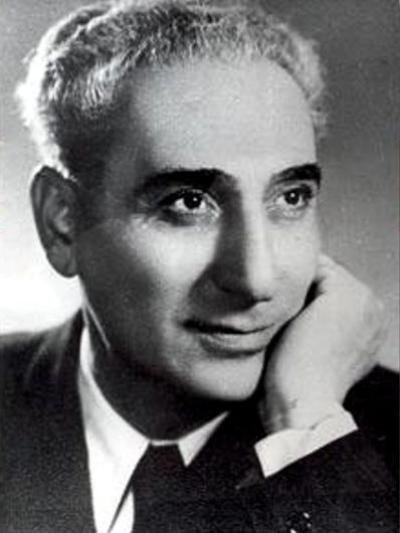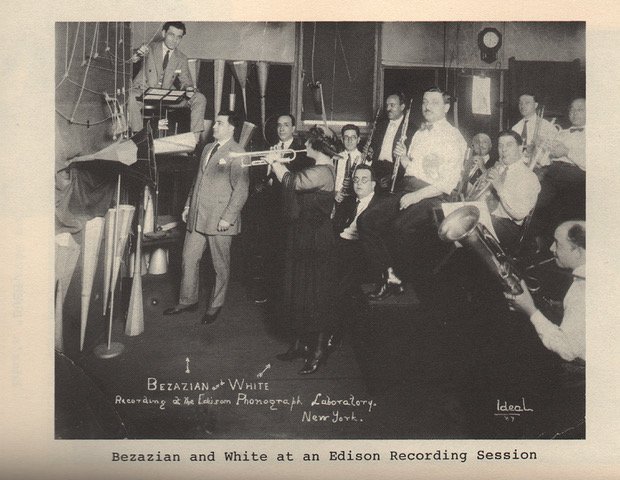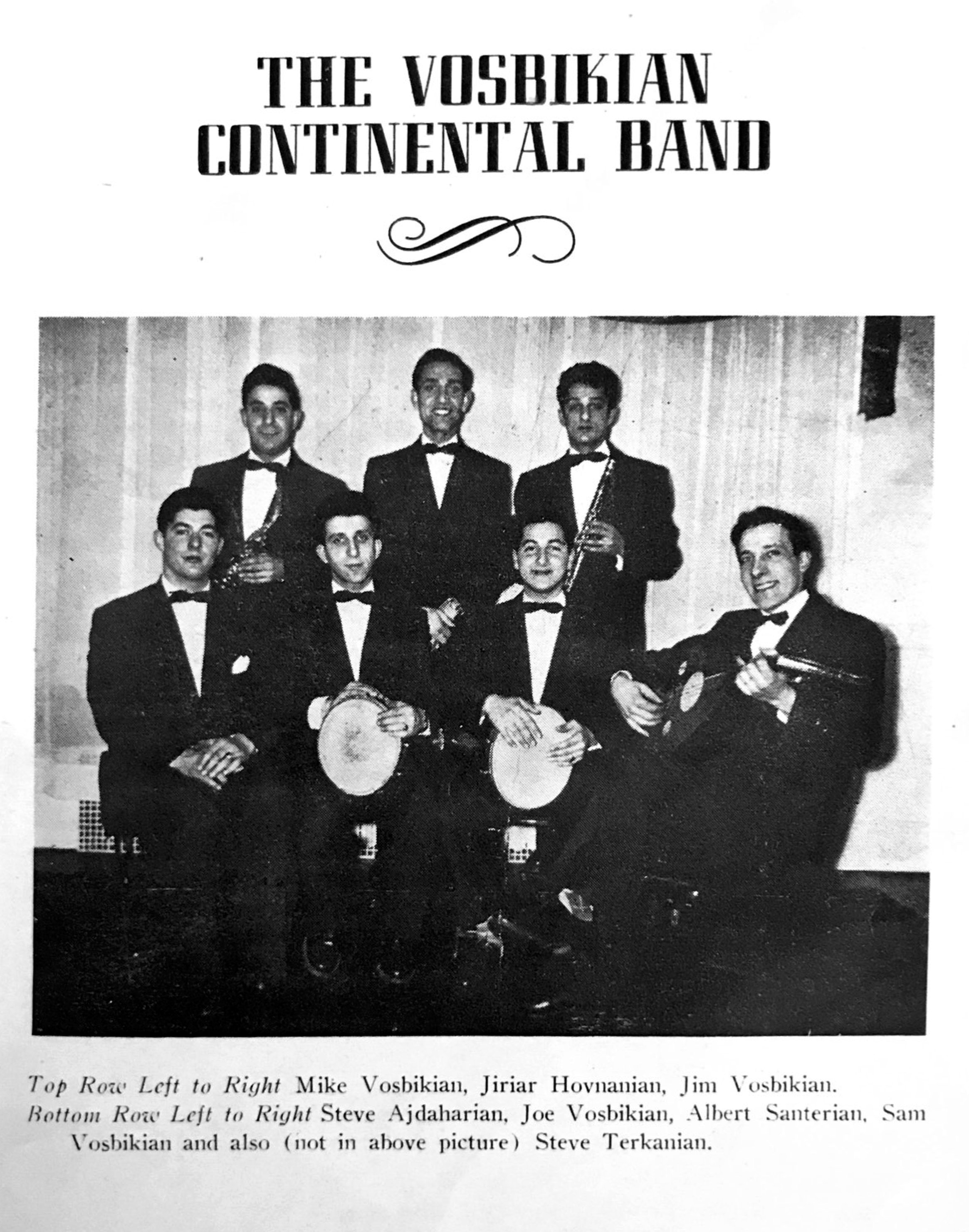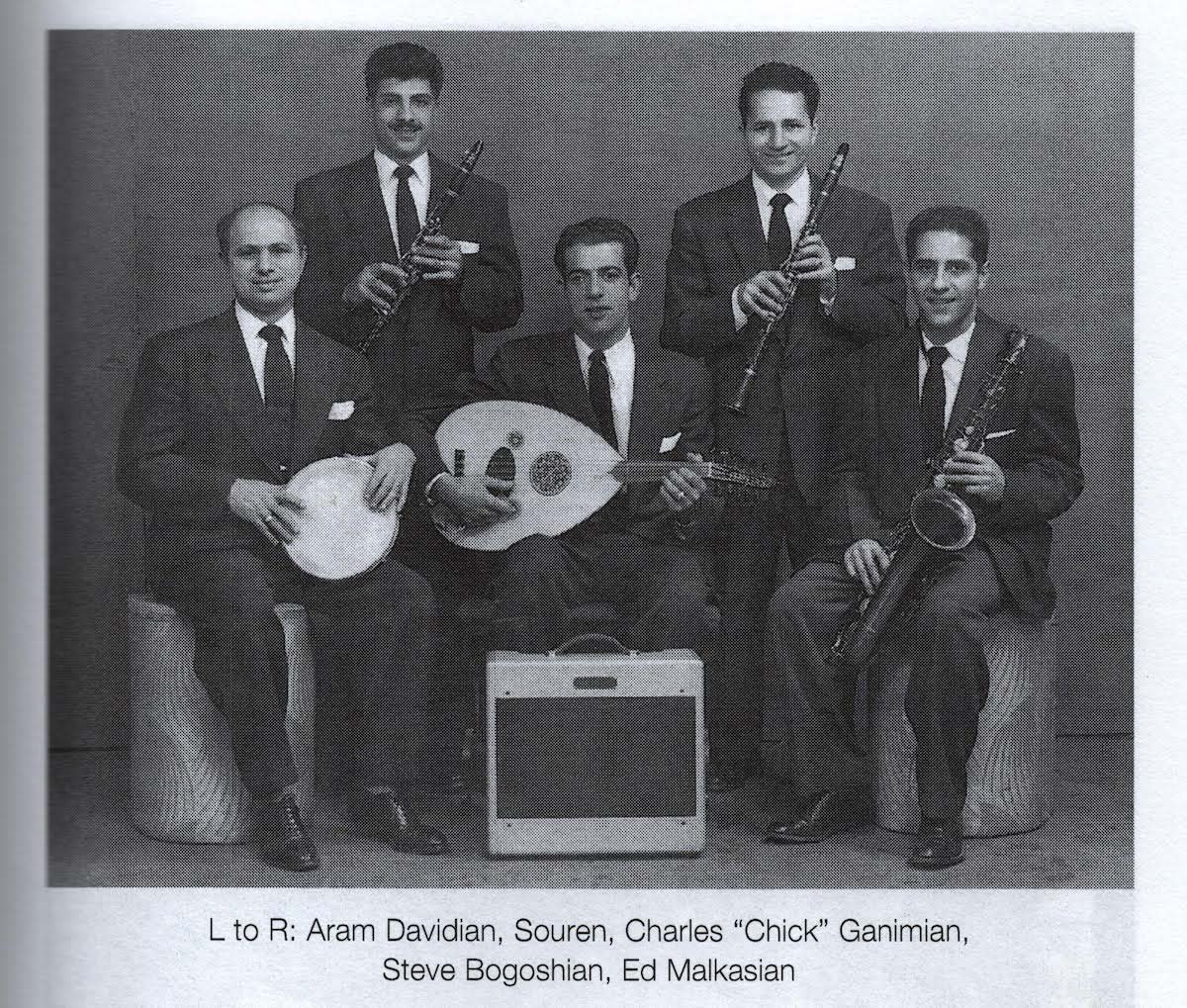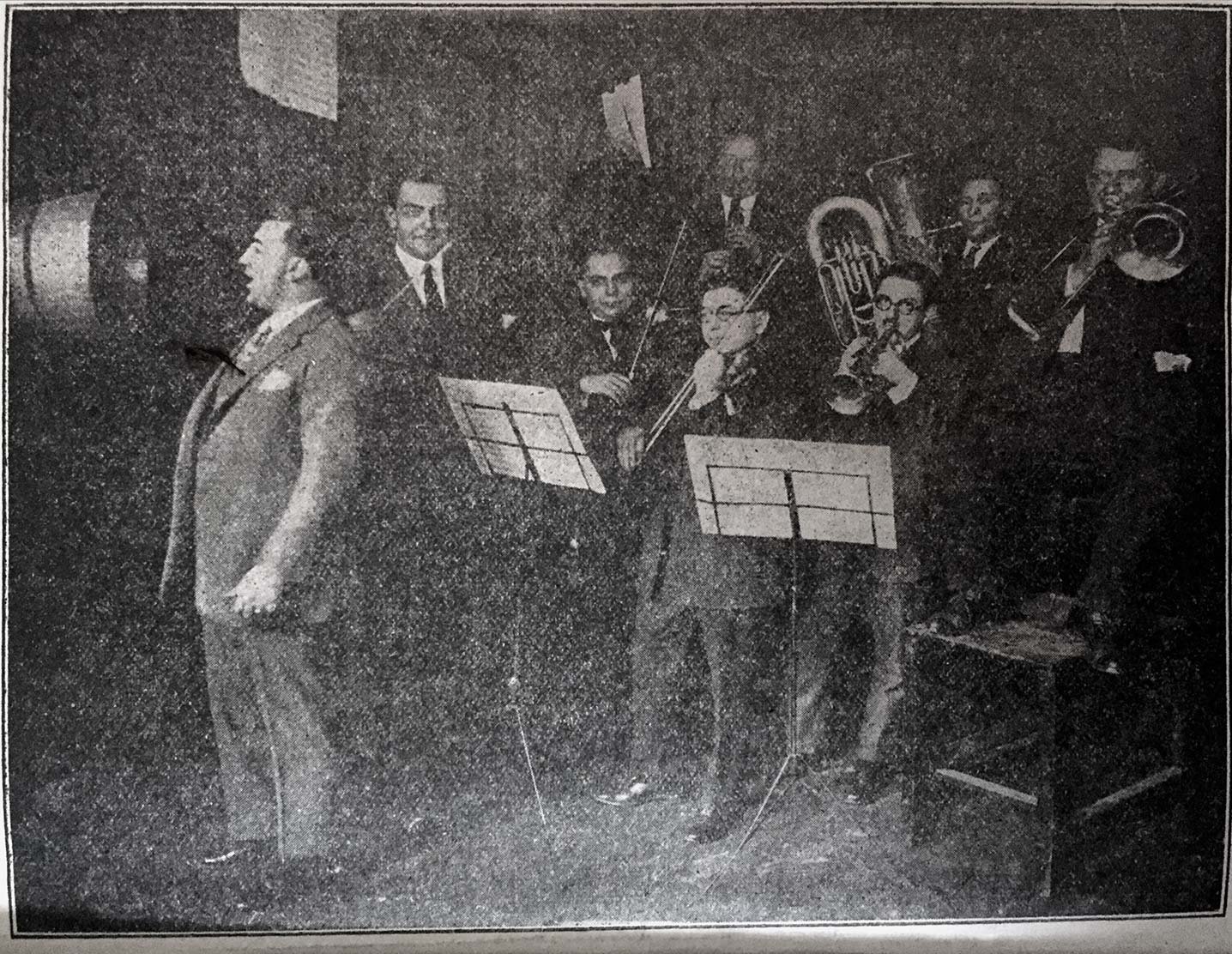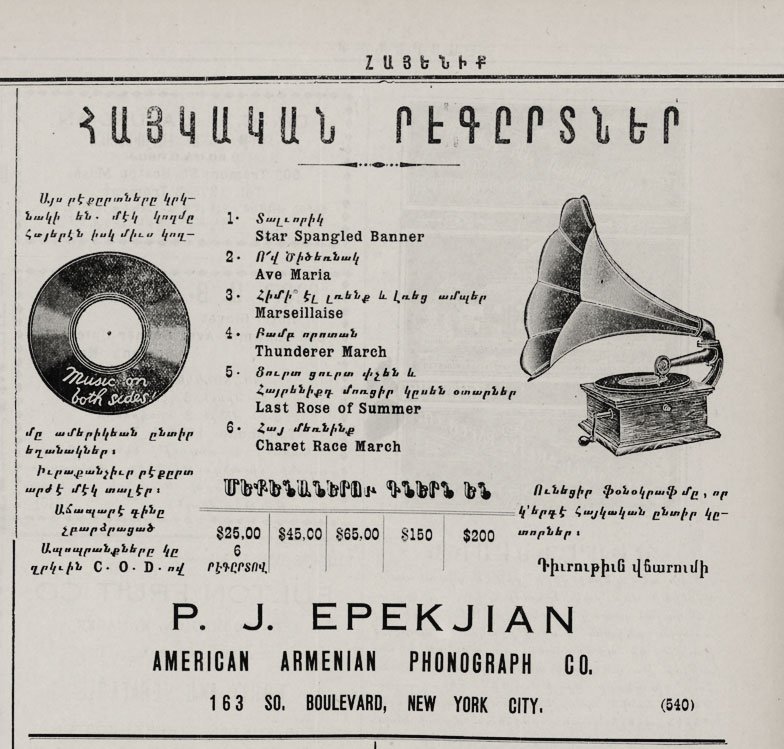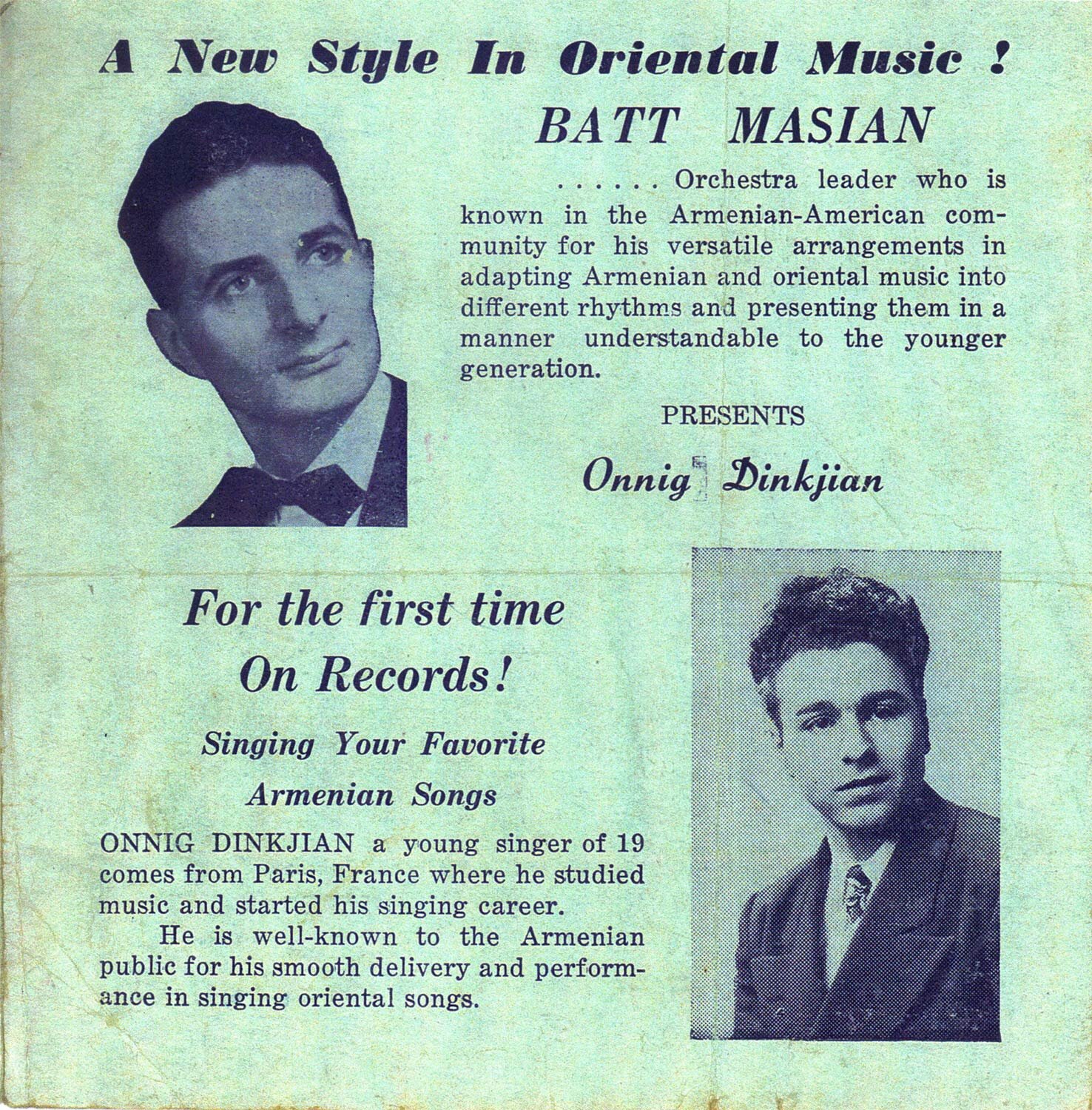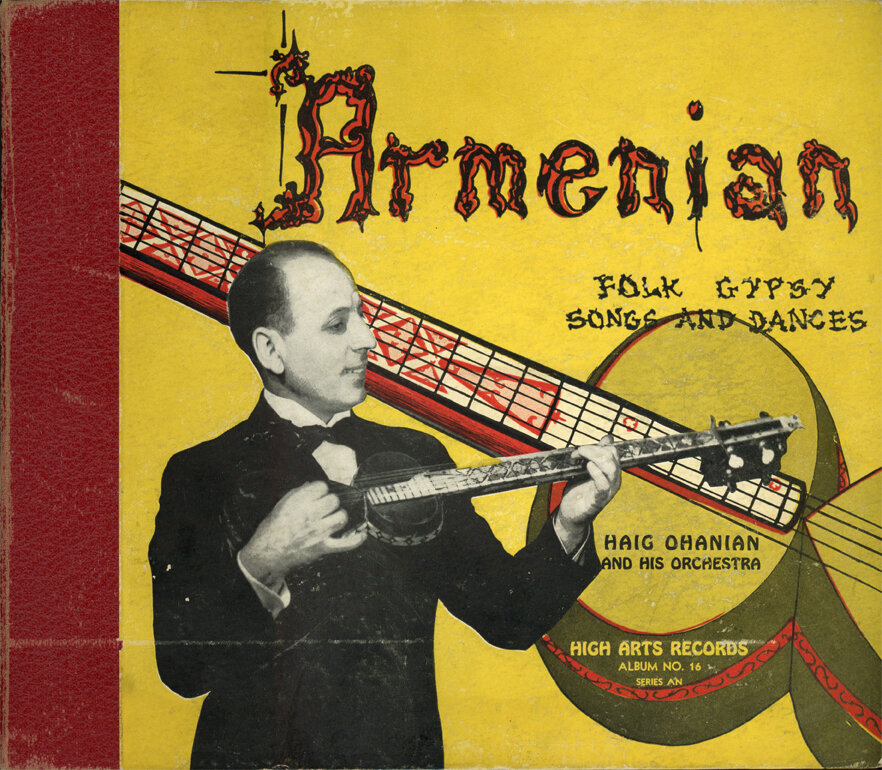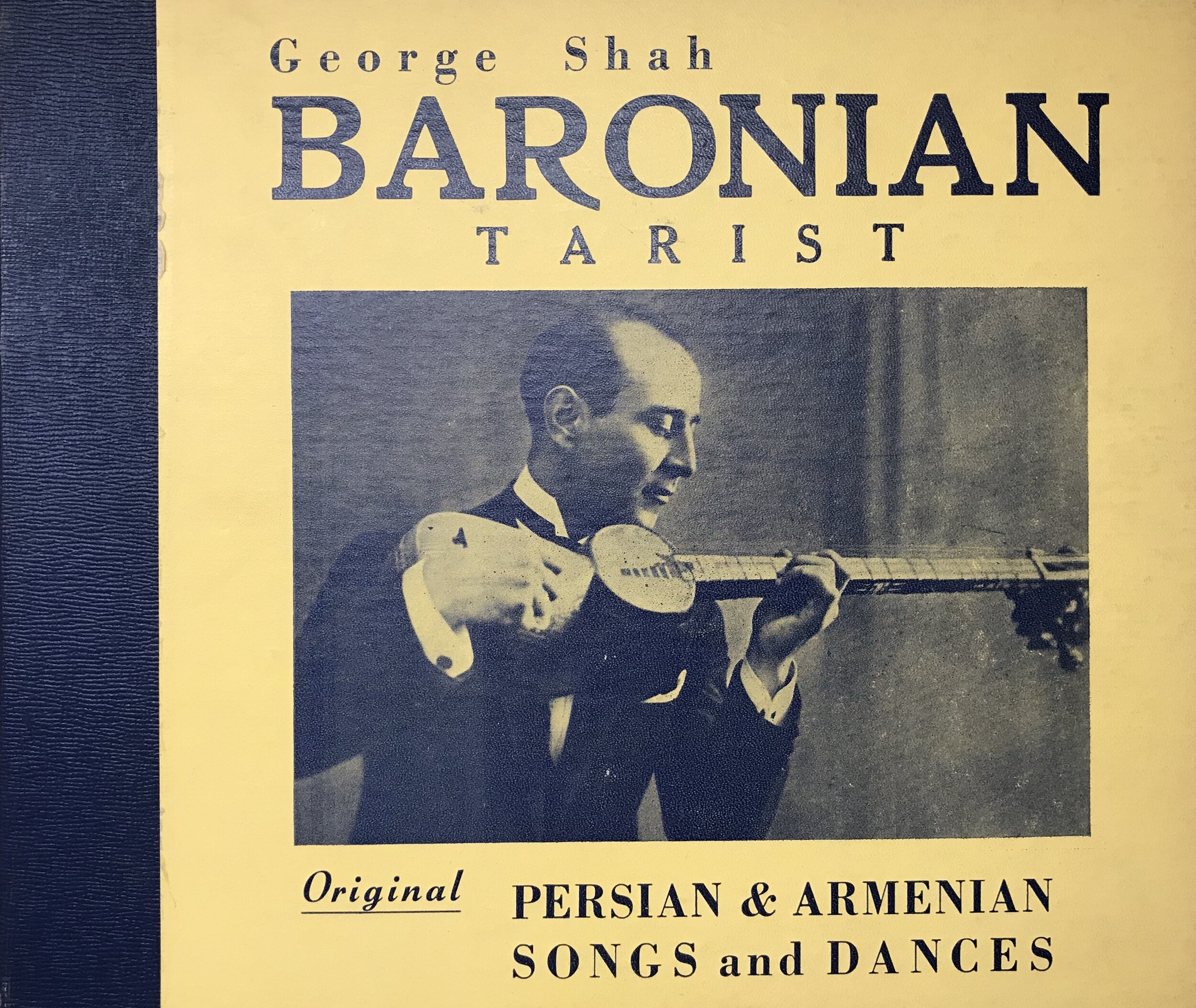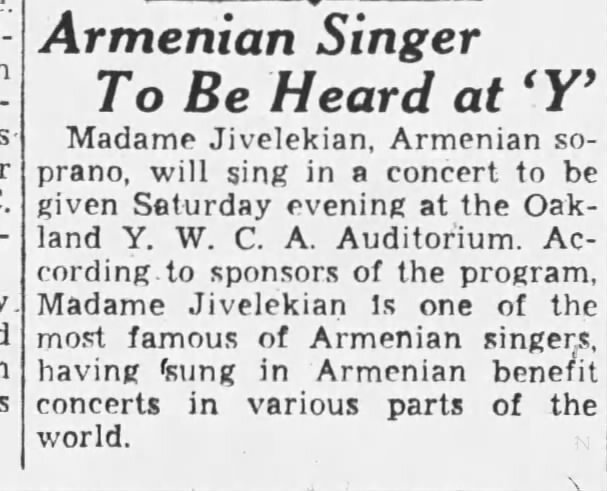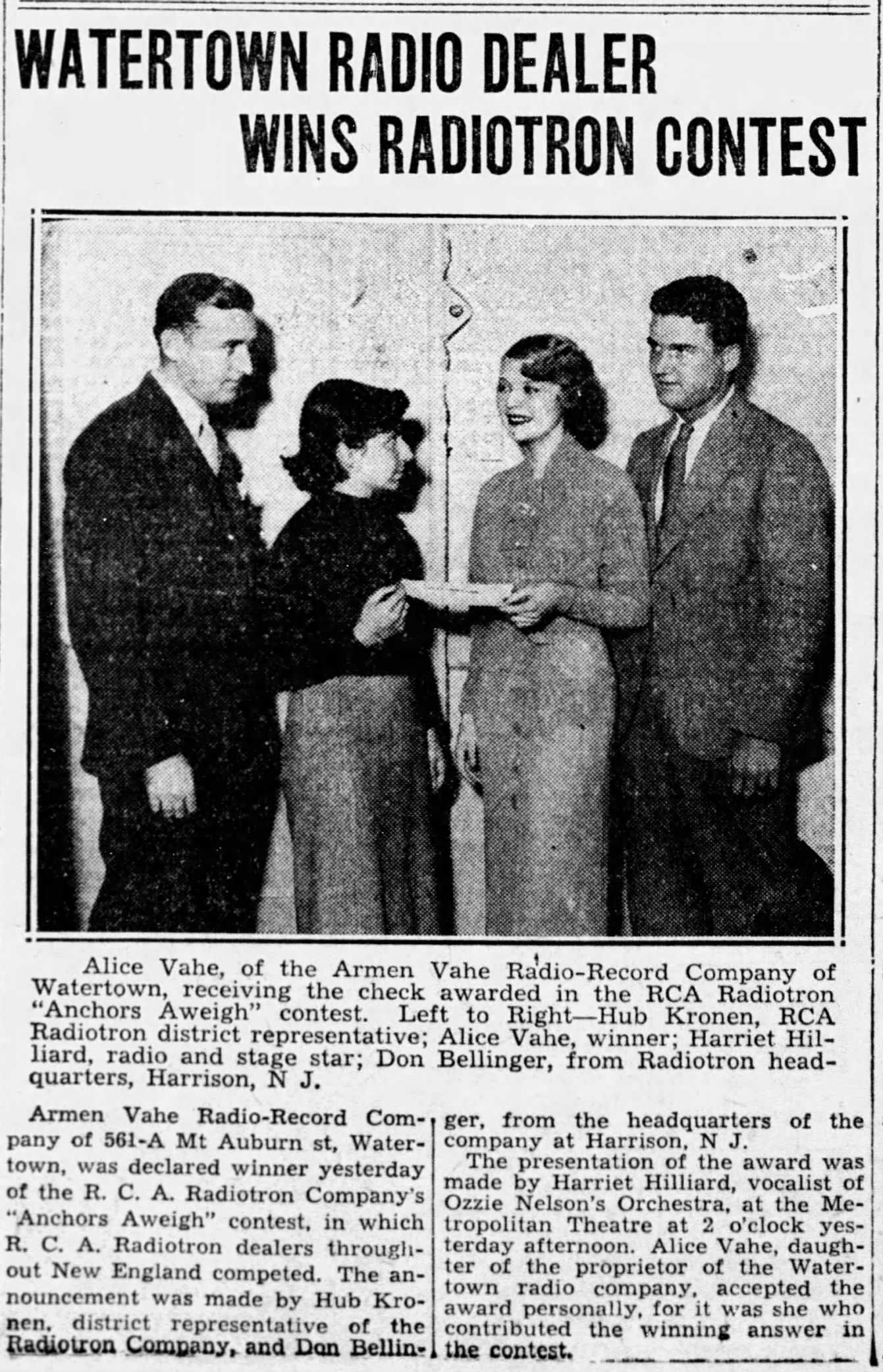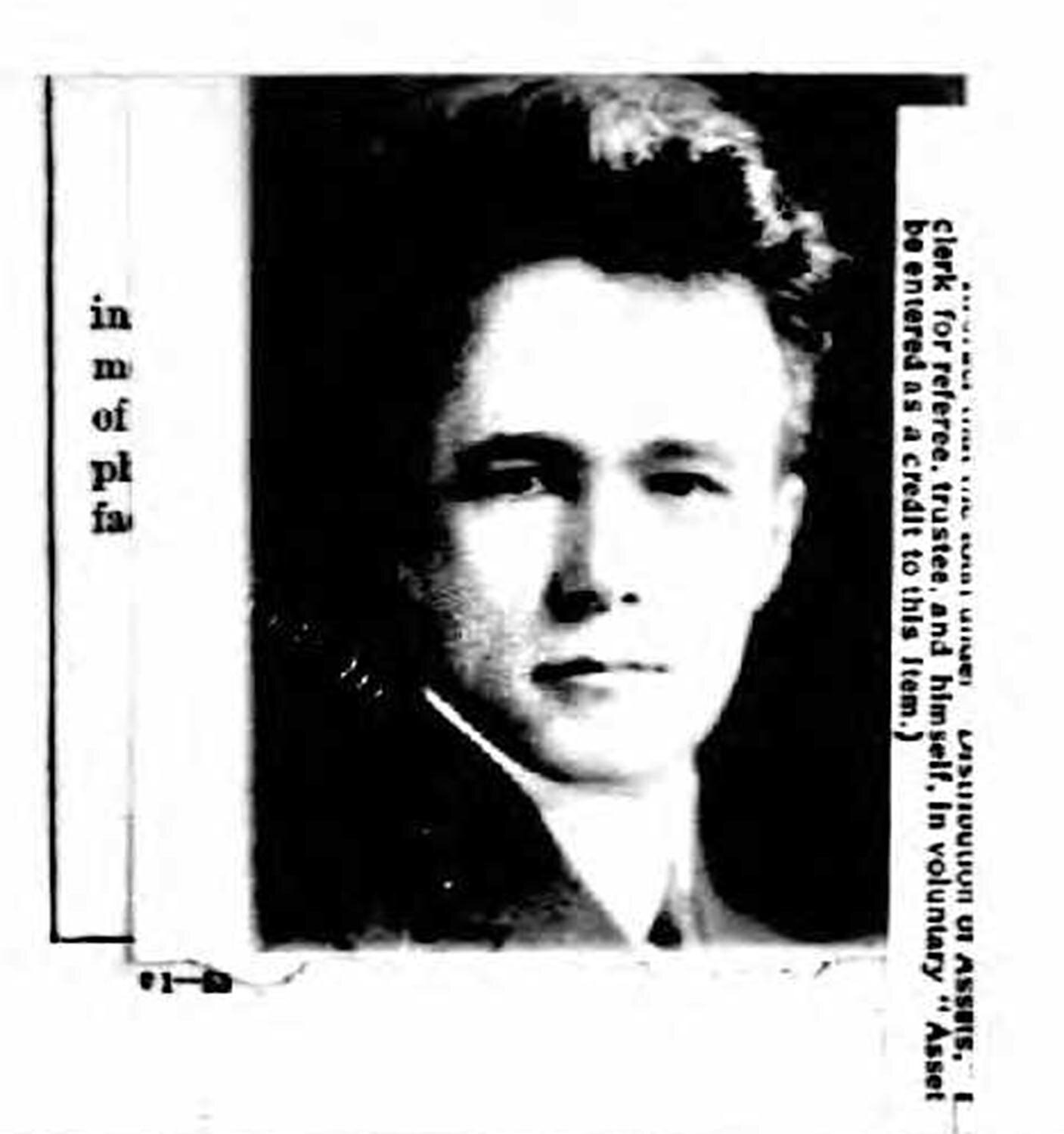Sound Archive
The following are selections from the museum's roughly 3,000 disc collection of early Armenian recordings and musical ephemera. Explore the links below to listen to songs, learn about pivotal musicians and see images of original records.
A special thanks to Jesse Kenas Collins, Harry Kezelian, and Harout Arakelian whose ongoing contributions of research and consultation have been critical to assembling the writings presented here.
A special thanks to the SJS Charitable Trust for their generous support of our work to digitize and share our collection of 78 rpm records.
Ardashes Kmpetian: Recitations from the Ararat Label of Paris
As a young man Ardashes followed in his father's footsteps, gaining acclaim for his recitation of lyrical narratives, a musical form of storytelling. Born on March 10, 1900 in Gyumri (then Alexandropol) in the Russian Empire, Kmpetian was raised in a musically rich environment. His father, Ashough Pesendi (born Mardiros Kmpetian), was a renowned performer among both Turkish and Armenian audiences in his native Sebastia. After the Constitution of 1908 was announced, he, like many other Armenians, gained hope and returned to the Ottoman Empire.1 Ardashes began his career as a stage actor, joining the Arevelyan Taderakhump (Eastern Theatre Troupe) under the direction of Mihrtad Haygazn. But just as his fledgling career was beginning to take off, Kmpetian would flee the newly established Turkish state in 1923, settling in Paris.
Artie Barsamian: “King of Armenian Swing”
As part of our ongoing series highlighting Armenian-American musicians from the postwar era, this profile features the recording career of Boston's own "King of Armenian Swing," Artie Barsamian. We are also celebrating the release of a book by clarinetist, musicologist, and educator Hachig Kazarian, Western Armenian Music: From Asia Minor to the United States (available in the museum's bookstore.)
Shara Talyan: Saro at the 1939 World's Fair
For the third time in the Sound Archive series, we are exploring material from the Museum's collection of Soviet Armenian recordings. In previous posts, we've discussed a variety of artists representing the diversity of Soviet Armenian music, from folk styles to the Western classical tradition. We’ve touched on the conservatory and state ensemble structures (which codified aesthetic standards set from Moscow among state-affiliated musicians), as well as some individuals, like Tatul Altunyan, who formed and ran the state ensembles.
Yeprad Records: Songs of Kharpert from Kaspar Janjanian
As a recurring theme here on the Sound Archive, we've explored the cultural preservation undertaken by Armenians from Kharpert who built new lives in and around the Northeast in the early 20th century. Before arriving in the United States, these individuals were first driven from their homeland in Kharpert during the massacres of 1895-96, and ultimately deported during the Genocide of 1915.
Those who did survive and seek refuge abroad understood the acute vulnerability and preciousness of their cultural heritage. So It’s no accident that in the 1920s, several of these individuals personally invested in recording and publishing folk songs from the Kharpert region. We’ve discussed the most prolific of these musicians, Vartan Margosian. But here we would like to introduce the recordings of Kaspar Janjanian, who recorded on the Boston-based Yeprad Record Company, a label with only three known discs in its catalog.
Sound Archive: 2023 Year in Review
Over the past year, the Sound Archive project has taken a step forward. In addition to the monthly posts here on the webpage, the Museum hosted two listening events under the Sound Archive umbrella this fall. Meanwhile, our web features are covering the full range of our collection. Along with more "conventional" musical recordings, we've highlighted sound recordings that touch on Armenian cultural, political, and educational history, as well as the history of recording technologies.
Edward Bogosian: Songs, Satire, and Theatrics of “Maestro Yetvart”
This month the Sound Archive turns to another canonical figure in the history of 20th century Armenian American recordings, Yetvart “Edward” Bogosian, affectionately referred to by friends as "Maestro Yetvart". His work is as comic, playful, and bawdy as it is profound and impactful. Like several of the post-war bands we’ve discussed before, Bogosian's music is often mentioned in reference to the modern Armenian American music known as Kef. But artists like Bogosian and his peer Hovsep Shamlian predate and exceed this classification.
NBC Broadcast Put Spotlight on Armenian Question & Armenian National Chorus
NBC Radio of San Francisco produced a captivating 20-minute segment about Armenia in 1945, on the sidelines of the UN meeting of 50 Allied nations. It highlights the Armenian National Chorus and advocacy in pursuit of the Armenian Question led by celebrity chef George Mardikian and attorney Souren Saroyan of the Armenian National Committee.
Yeranouhi Mooshian: Lesson 1
As the “back to school” season begins, the Museum’s emphasis on language preservation and education continues. For this Sound Archive edition, we are sharing a recording not by a professional musician, but rather by a schoolteacher and community servant who only recorded one single disc. This unusual, one-of-a-kind record is a celebration of educators, and serves as an instructional resource for the Armenian language teacher.
Songs from Armenia: Soviet Armenian Recordings in America
Today, we’re revisiting Soviet Armenian recordings through discs produced by the Armenian Progressive League of America, headquartered in New York City. Active from 1938 to 1990, the League was one of many political organizations formed by Soviet-aligned Armenian Americans in the years after 1920, when the First Republic of Armenia fell. In addition to publishing Lraper (The Herald), which reported on news from Armenia, the League distributed reissued material originally recorded in Yerevan. The recordings presented here were published on a label called Yerker Hayastanen (Songs from Armenia). The League ran advertisements for these discs from 1949 into the 1960s, making these titles available to Armenians in the United States. The Armenian Museum of America is fortunate to have a nearly complete collection of the records produced on Yerker Hayastanen. Four songs from that collection are presented here.
A Gathering of the Armenian Spirit: Museum Digitizes Incredibly Rare Recording of William Saroyan and Friends
This month the Museum is exhibiting two watercolors by the award-winning novelist and playwright, William Saroyan.To accompany these pieces, we are also highlighting sound clips from a homemade lacquer record featuring the iconic writer. In the 1930s and 1940s, we witnessed an explosion of people documenting all kinds of events using commercially available record lathes.These suitcase-sized machines were turntables with a steel needle that instead of playing back a record, etched sound onto a blank disc covered in a lacquer material. The sound quality was often poor but the technology was revolutionary in making home recording accessible for the first time.
Hovsep Shamlian: New Music For Armenian Orchestra
Our Sound Archive series often celebrates the work of the early 20th century folk musicians who documented the music of their homeland upon arriving in America, as well as the music of their children, who we might think of as the post-WWII “Kef generation.” While shaped by the musical path between these generations, the singer and songwriter Hovsep Shamlian is key to that development. Many songs that Hovsep Shamlian wrote and recorded in 1927 are staples of the Armenian-American musical repertoire, particularly songs like Sheg Mazerov and Hasaguet Partzer (now known as Kale Kale). Another notable Shamlian composition which is still heard from “kef” bands today is Gamavor Zinvor, recognized as a historic testament to the Armenian Legionnaires who fought in WWI under the French flag.
Yenovk Der Hagopian: Voice from the Valley of Armenians
In this Sound Archive edition, we are featuring four songs by Vanetsi folk musician and artist Yenovk Der Hagopian. As you may recall Yenovk’s name from the Museum’s “Treasures from Our Collection” video, which Curator Gary Lind-Sinanian presented in 2022. This post serves as a brief reintroduction to Yenovk and an opportunity to let his voice be heard through the recordings he brought into the world 80 years ago.
Yenovk Der Hagopian was born in Ishkhanikom village (present day Bakimli) on May 24, 1900. The village is near Lake Van but set back against the mountain's foothills in the history-rich valley known as "Hayots Tzor" or “Valley of the Armenians.” Yenovk’s father, Hagop, was a priest and an Ashough (or troubadour) in the style of Sayat Nova. Yenovk traveled with Hagop learning much of the repertoire he would go on to record, sung in the numerous regional languages and dialects. Equally formative to his youth was Yenovk’s relationship to Manoog Adoian who was from a nearby village, Khorkom. The world would come to know Manoog as the seminal abstract painter Arshile Gorky.
A Souvenir: Lacquer Discs and the Armenian Argentine Story
Given the Museum’s location in the US, many of the recordings we have discussed in the Sound Archive represent the output of the Armenian American diaspora, but the nature of diaspora is inherently global and the unifying aspect of a common culture means that sometimes documents end up far from their place of origin. Today we present one such record that provides a window into the Armenian Argentine diaspora, as well as a special subcollection of non-commercial lacquer discs.
The Gomidas Band: Expanding Tradition
The post-WWII Armenian-American bands have been a recurring theme here at the Sound Archive. These sons of immigrants gave new impetus to the Armenian dance culture in the Diaspora by blending their Anatolian roots with the brash sounds of American jazz, giving rise to “kef music.”
This history is intertwined with the story of the Gomidas Band — which is largely the story of Henry “Hank” Mardigian. Mardigian was born and raised in Philadelphia to a family from Malatia. He first apprenticed under musician Sam Vosbikian as a fill-in banjo player and then saxophone player in the Vosbikian Band, while two of the members were off fighting in WWII. In 1949, he was approached by Johnny Kitabjian, a friend from AYF, to help him with a band he was forming. This band became the Gomidas Band.
Guy Chookoorian: Opening the door…
The Armenian Museum of America’s Sound Archive begins 2023 with a celebration of Guy Chookoorian’s fascinating and humorous musical contributions. Guy was a musician, singer, comedian, and actor. Proudly American, Guy served in World War II as a member of the 331st Bomb Squadron of the 94th Bomb Group, flying 32 missions over Europe. He was the son of heroic Genocide survivors from Yerzinga. Along with his sister Sue, Guy cofounded the Armenian-American Theater Group in Fresno in the mid-1940s. Even as he thrived in Hollywood, Guy would never forget his heritage. Celebrating Armenian culture throughout his entire career, he helped to preserve the folk songs of his native region.
Sound Archive 2022: Year in Review
As we enter the New Year, we’re taking a look back at the artists and topics covered in the Sound Archive posts since they began two years ago! We hope this overview helps emphasize the depth and richness of Armenian musical history encompassed in the collection. For half a century now, the Museum’s collection of 78rpm records has grown, thanks to generous donors who have been entrusting us with their personal collections. The diverse histories, taste, and experience of those donors is reflected in the recordings found in the collection, providing a rich pool of music to share and a wide range of stories through which we can explore Armenian culture and music.
We hope you enjoy the selections that we're shared so far. For those of you who may have missed previous posts or are just discovering the series, we encourage you to take a look back and explore previous sounds from our archives!
Hrand Markar Tashjian: The Early Days of Reissues
The Sound Archive presents digitized versions of 78 rpm records from our collection. This month we are featuring record distributor Hrand Markar Tashjian. Tashjian was a trailblazer, taking matters into his own hands when Armenian music was almost impossible to get your hands on in the 1940s and 50s. He reissued out of print recordings from major labels on a series of his own imprints.
This month's post includes four digitized and restored songs: Yaylouges Gorav, Siroung Groung, Amen Hayr Sourp, and Vart. Special thanks to the SJS Charitable Foundation for their generous support of our work to digitize and share our collection of 78 rpm records.
The Vosbikian Band: Pioneers of Armenian-American Culture
This Sound Archive highlights one of the most influential bands in the history of the Armenian community in America. Known and beloved by fans on the East Coast for generations, the Vosbikian Band was the first American-born Armenian dance band, raised outside of their parents’ historic homeland in Armenia and Asia Minor.
The Vosbikian Band started with three brothers, Sam (Sahag) Vosbikian (1919-2012), Mike (Manuel) Vosbikian (1921-2019), and Joe (Hovsep) Vosbikian (1924-2012). They were born in Philadelphia to Bedros and Vartanoush Vosbikian, who were natives of Malatia. Bedros was a clarinet player who performed with his brother Thomas on violin, with other friends and cousins providing vocals and dumbeg (hand drum) beats.
An Introduction to Armenian Soviet Recordings: Arev Baghdasaryan & Levon Madoyan
Portrait of Arev Baghdasaryan in full traditional wardrobe (Source: Armenian Visuals on Twitter, Dec 21, 2021)
In this 18th Sound Archive post, we feature four songs by two highly accomplished musicians. Born in Shushi, Arev Baghdasaryan studied dance and music in Baku during the 1930’s. The arrangements of the folk songs “Garunkner'' and “Hayots Ashkharh'' feature her distinctive sound. The other two pieces, “Akh, Im Champen” (Ah, My road) and “Shirakskii Tanets” (Dance of Shirak) showcase an iconic Armenian instrument. On this Soviet 78 rpm record manufactured in Moscow, we hear the highly accomplished duduk player Levon Madoyan.
Souren Baronian: A Jazzman with an Armenian Swing
Group portrait of the Nor-Ikes Orchestra featured in Souren Baronian’s memoir “The Magic Carpet Ride: My Life So Far”
In post-World War II America, a generation of American born Armenians began recording music. In 1949, the Vosbikians and the Nor-Ikes would redefine Armenian music and create a cultural phenomenon. Other bands followed including the Gomidas Band, Aramite Band, the Orientals, the Ararat Band, and the Barsamian Orchestra. This profile of Souren Baronian is the beginning of a series of posts related to the young Armenian-American musicians.
Torcom Bezazian: The Prolific Baritone
With a short yet colorful career in the United States of America, Torcom Bézazian can be considered the most prolific Armenian recording artist of the early 78 rpm era and the only Armenian to record with the three major labels of the era, Columbia, Victor and Edison. Born in Constantinople on September 23, 1889, Bezazian fled the Ottoman Empire and pursued an education in France where he graduated with a degree in engineering from the University of Nancy. Bezazian forsook his career in engineering, and began a serious study of music. Like Armenag Shah-Mouradian and Krikor Proff-Kalfaian, Bezazian studied with Vincent D’Indy. Torcom arrived in the United States in 1913 and over the next decade and a half the baritone enjoyed a successful career on the opera and vaudeville stages.
Mesrob Takakjian: An East West Passage
The three songs presented today all feature the master clarinetist Mesrob Takakjian. The first, titled Yes Sirer Em (I Have Loved), is a clarinet solo and a clear display of Takakjian’s skill. Also included are Gigo, a song including a strong introductory clarinet solo and March of Antranig, a well known patriotic ballad which is interpreted by Takakjian in a 10/8 rhythmic style.
Born in Palu, clarinetist Mesrob Takakjian arrived in the United States in 1912 as a teenager; he would resettle in Fresno, California in the early 1920s. While living in Providence, Rhode Island, Takakjian began his music career. His name is first seen on a record in 1924/5 on the Margosian Records label, though it is presumed he was recorded earlier in the late 1910s. His promising music career in the New York area was cut short when he contracted tuberculosis after he allowed a fellow musician to use one of his reeds, thus leading to his migration to California for healthier weather. He would appear on two discs recorded for Columbia Records in Los Angeles in 1929, accompanying Oscar Kevorkian.
Zabelle Panosian: Another Take
Today's post features the stunning voice of Zabelle Panosian, an Armenian soprano and recording star of the early 20th century. Once a household name for Armenians in the 1910s and 1920s, the recent publication of Zabelle Panosian: I am Servant of Your Voice, a book and CD compilation by Canary Records, has taken great effort to bring Zabelle back into focus and let her voice be heard and celebrated again in the 21st century.
Masha Sourabian - Pioneer of the Armenian Stage
Masha (Marie) Sourabian had an illustrious career on the Armenian stage as an actor and vocalist. She was born in the town of Yekaterinodar, modern day Krasnodar, Russia on February 16, 1896. Her musical training began at the Moscow Conservatory of Music. Masha met and married Armenian actor Setrak Sourabian in 1919, in Tiflis. Together they formed the Hay Dramatic Operet Khoump (Armenian Dramatic Operetta Troupe) and began touring with stops in various Armenian communities with performances in Tiflis, Yerevan, Baku, Smyrna, and Constantinople.
Like Father, Like Son: The Joyful Music of Stepan and Haigaz Simonian
Among the numerous musicians from the Kharpert region that recorded for Columbia Records in the 1920s, the father and son duo Stepan and Haigaz Simonian stand out for their exuberant renditions of regional dances. Stepan Simonian was born in 1887 in Mezire and came to the United States in 1907, settling first in Haverhill, then later in Worcester, MA, where he worked as a cobbler. He and his wife Sophia Berberian, a Kharpert Assyrian, had two sons and two daughters. Their oldest son and Stepan’s collaborator, Haigaz, was born in 1909 in Worcester.
Nevart Dzeron-Koshkarian: Portrait of an Artist
Nevart Dzeron-Koshkarian, sometimes known as Nouart, was a fine artist and art educator. She was born in Perchanj, a village that was south of Kharpert. She would arrive in the United States in 1893. Daughter to engineer and author Manoog A. Dzeron, who wrote, “Nevart having received her preparatory education in Worcester and Chicago, completed a 7- year course at the Chicago Art Institute and graduated with honors as an artist. For an additional year she went to France and Italy to refine her art. She married Prof. Bedros Goshgarian. They settled in New Jersey. Nevart has always remained a patriotic Armenian. During the Near East Relief fundraising she traveled to important centers in America, lecturing on indigenous Armenian music and singing Armenian songs.
Sound Archive 2021 - Year in Review
As we enter the New Year we’re taking a look back at the artists and topics covered in the Sound Archive posts since they began in March of 2021. We hope you enjoy the selections here which bring together on one page some of the music we’ve shared to date.
Vartan Margosian, the Nightingale of Kharpert
Portrait of Vartan Margosian reclining in a chair, circa 1920s (Photo Courtesy of the Margosian family archive)
Vartan Margosian’s style of music was unique and will probably never again be repeated. He was not a highly trained musician, and he wasn’t even a “master player” in the folk tradition. There were probably any number of Armenians like him, who knew how to play an instrument and who knew the folk songs of their local area. That doesn’t mean he wasn’t great, but one asks oneself how many Vartans we lost due to the Armenian Genocide. Vartan’s special quality lies in two things, as far as this listener is concerned: his near-heroic attempt to document the songs of his native land by printing an incredible amount of records on his own dime, and his irrepressible spirit which shines through in all his recordings and in the surviving photographs, a man who must have been a naturally happy person, subjected to loss and destruction of his homeland and most likely, his parents and extended family. Vartan’s singing verges from deeply, emotionally melancholic to sprightly, happy, and contented, reflecting his and his people’s loss on the one hand and his successful realization of the American Dream and happy family life on the other. The songs included here are mostly from his early recordings and mostly from the second half of 1923 and the first half 1924.
Armenag Shah-Mouradian: Beyond The Protege Of Gomidas
Portrait of Armenag Shah-Mouradian along side a concert listing in the Jan 26, 1916 issue of The Michigan Daily. (Image: Newspapers.com)
Armenag Shah-Mouradian is one of the all-time exemplars of Armenian music. Commonly recognized as “the protege of Gomidas Vartabed,” he himself had a huge impact on Armenian music aside from interpreting the works of his famous teacher.
Shah-Mouradian was born in 1878 in the city of Moush, in the heart of Ottoman-ruled Western Armenia. His father, Sarkis Shah-Mouradian, was known as “Tarpin Srko” (Sarkis the Blacksmith). Srko was a gregarious figure and music lover whose door was always open, and was well-liked by the local Armenians, Kurds, and Turks. An amateur player of the boulghari, a small type of saz (long-necked Anatolian lute), Srko knew how to sing ashough (minstrel) songs by heart and local musicians who played the zourna, dap, and damboura (a larger type of saz) often visited the family.
Noticing young Armenag’s inclination to music and attraction to the boulghari as early as the age of 3 or 4, Srko told his wife to keep the instrument from the boy, so that he wouldn’t grow up to be a “chalghujuh” (derogatory term for a professional folk musician). He did, however, encourage Armenag to sing in church, and asked the local teacher to teach the child liturgical singing at the age of 5 or 6. Shah-Mouradian began to sing at Moush’s St. Marine church at the age of 8, and remembered that his first solo was “Amen Hayr Soorp” in the Second Mode (ԲՁ). His father also asked an older local boy who attended the “United Associations” high school to teach Shah-Mouradian Armenian patriotic songs. After attending the local grammar school, Armenag himself also attended the “United Associations” high school in Moush.
O Swallow, Karekin Proodian and the Folk Interpretation of Armenian Patriotic Songs
This month’s music presentation features the intersection of so many aspects of the Armenian experience that it lends itself to the question, what makes a piece of music Armenian?
Many are familiar with the debates surrounding the influence of nearby Middle Eastern musical cultures on that of the Armenians, even including the translation of songs from other languages into Armenian. But oftentimes Armenian music held up as “classic” has also been translated from Western European languages, a perhaps lesser known phenomenon.
Armenians in Dikranagert, circa 1912 ready for merriment with a kanoun, a violin, a waterpipe and a bottle of arak. Seated at far right is Karekin Proodian. (Image: Project SAVE Armenian Photograph Archives, Courtesy of Antranig Tarzian)
Hovsep Joseph Bedrosian: Master Zourna Player
On August 17, 1940 in the Central Valley of California, the Bedrosian family of musicians, led by Hovsep Joseph Bedrosian recorded four unique songs on the privately owned record label GME Records. The Armenian Museum of America’s Sound Archive celebrates these musicians and their contributions to recorded music.
It was a Saturday in the San Joaquin Valley of California, a typical weekend in the summer, the soil was hot and families had gathered in the farmlands of Fresno. On August 17, 1940, Hovsep Bedrosian was joined by his son Avedis and his cousin Bagdasar Bedrosian for a festive recording session. Much of the information related to these recordings is captured in the grooves of these discs as each song begins with a brief introduction by Avedis Bedrosian in Armenian and English. While Avedis is given the title of “director,” these recordings highlight the musical mastery found within Hovsep Bedrosian and his instrument, the zourna. During these sessions he was accompanied by his cousin Bagdasar on the davoul.
An Enduring Sound: Onnik Dinkjian and the Legacy of Armenian Music in America
This month’s featured artist from the Armenian Museum of America’s Sound Archive truly embodies the definition of a community servant. For nearly nine decades, Onnik Dinkjian has dedicated his time serving the Armenian community by sharing his remarkable talent, the power of his voice. Onnik Dinkjian’s story begins in Dikranagerd where his biological parents Garabed and Zora Milliyan were both born and raised. The Milliyans settled in Paris, France and in 1929 Onnik was born as Joseph Milliyan. Five years later catastrophe struck the family leaving Onnik and his sister orphaned. Onnik’s godparents Nishan and Oghida Dinkjian would become his adoptive parents. Later in life, Onnik would discover that his birth father Garabed also was a musician, a player of the oud. During Onnik’s childhood the folk singing of his mother Zora and the music of the Armenian church captivated him, these inspirations that would empower Onnik to honorably dedicate his artistic career to creating music to further Armenian culture. In July of 1946 Onnik and the Dinkjian family relocated to the United States, Union City, New Jersey. His musical start would actually begin weeks before their departure from Paris, as Onnik had the opportunity to sing as a soloist at the Armenian Cathedral of St. John the Baptist, in Paris, under the direction of Nishan Serkoian.
The Tar
Key instruments, their origins and performers
The tar and the work of Haig Ohanian and George Shah-Baronian
The tar is a long-neck lute prominent throughout the Caucasus and central to Armenian folk song traditions.
The instrument has an hourglass shaped body carved of mulberry and covered with the dried membrane of cow heart. It has between 6 and 11 strings and 25 - 28 adjustable frets.
In the 1940s two Armenian musicians and entrepreneurs recorded and performed extensively on this instrument in the United States, Gerorge Shah-Baronian and Haig Ohanian. Both operated their own private record labels to publish their works, and both presented the tradition of their instrument while also attempting to modernize it within an American context.
Nevarthe Jivelekian and Grikor Suni
Armenian tradition of classical sopranos
Nevarthe Jivelekian, Grikor Suni and the Victory Record Company of Malden, MA
Exploring the tradition of Armenian classical soprano singers which is rooted in Armenian Church Hymns as well as the work of Gomidas Vartabed.
Featuring a 1924 recording by Nevarthe Jivelekian, published in Malden, which documents her collaboration with the famous Armenian composer Grikor Mirzaian Suni.
Armen Vahe Radio Record
Entrepreneurs recording and selling records locally
Armen Vahe Radio Record -
Armen Vahe Radio Record was a store located at 561 A Mt. Auburn St. in Watertown, MA. It was owned and operated by Armen Vahe beginning in 1925.
The store sold appliances and records and had strong ties with the RCA record company. Armen also operated his own Oriental Records label.
Unique among the output on the label are several recordings featuring an ensemble of Armenian performers from New England, including violinist Manoug Toumigian (Rhode Island), clarinetist Toros Tatarian (Rhode Island), and Krikor Ohanian (Worcester, MA). The group performed songs in Armenian, representing the folk style of the Kharpert region.
The Tashjian Brothers
Pivotal Figures
The Tashjian Brothers and the first Armenian recordings made in America
Profile of Medros Tashjian and his brothers Nishan and Levon, who recorded the first Armenian songs to be published in America by Columbia records in 1909.
Three previously unknown records by the Tashjians have been found in the collection at The Museum and digitized.



